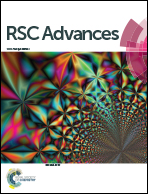Ceric ammonium nitrate (CAN): an efficient and eco-friendly catalyst for the one-pot synthesis of alkyl/aryl/heteroaryl-substituted bis(6-aminouracil-5-yl)methanes at room temperature†
Abstract
A simple, facile and convenient practical method for the one-pot synthesis of biologically relevant alkyl/aryl/heteroaryl-substituted bis(6-aminouracil-5-yl)methane scaffolds (3a–3u) has been developed using ceric ammonium nitrate (CAN) as a commercially available and eco-friendly catalyst via pseudo three-component condensation reaction between aldehydes and 6-aminouracils in aqueous ethanol at room temperature. The salient features of the present protocol are mild reaction conditions, good to excellent yields, high atom-economy, environmentally benignity, easy isolation of products, no column chromatographic separation and reusability of reaction media.


 Please wait while we load your content...
Please wait while we load your content...